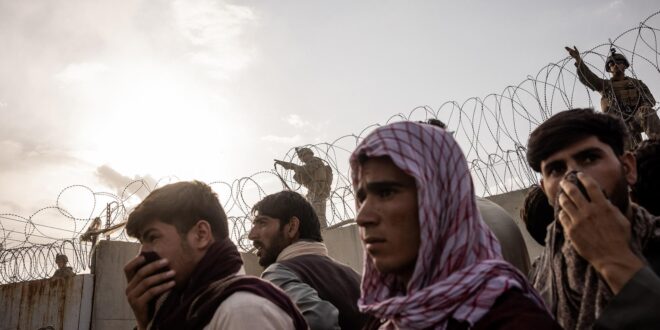Afghanistan’s humanitarian crisis urgently demands solutions to a ‘liquidity trap,’ stifled trade and blocked bank transfers.
The U.S. government needs to urgently prioritize saving Afghan lives, meeting basic human needs and stemming the free-fall of the Afghan economy. The unprecedented evacuation of some 100,000 people from Kabul airport in August demonstrated what clear objectives and a whole-hearted, government-wide focus can accomplish under the worst of conditions. While that scale of mobilization is not required now, a similar unity of effort and focus, this time on financial engineering, will be needed to deliver aid to the Afghan people and limit further economic damage in coming months.
Nothing can fully offset the economic shock from the Taliban takeover, the evaporation of some $8 billion a year in aid (equal to 40 percent of GDP), sanctions (which criminalize moving funds to the Taliban, Haqqani network and designated leaders) and the freezing of some $9 billion of Afghan foreign exchange reserves. The country is already facing a double-digit decline in GDP, rising prices of food and other necessities, and increasing unemployment, poverty, hunger and potential starvation. But if nothing is done the situation will get even worse, especially with the approach of winter.
In the absence of action, major parts of the Afghan economy will remain in free-fall and the urban sector will completely collapse. As a result, hunger and privation will increase further, already large humanitarian aid needs will multiply, and millions of desperate Afghans will be forced to try to leave the country.
While addressing these challenges will demand a multifaceted approach, one thing is clear: Keeping the Afghan private sector afloat is a form of humanitarian disaster prevention and a critical priority.
Nothing recommended here entails financial assistance to the Taliban government or termination of sanctions let alone formal recognition of the Taliban, or blanket unfreezing of foreign exchange reserves. What is required is a more holistic consideration of different risks and informed risk balancing and management as opposed to knee-jerk risk avoidance, along with flexible and proactive approaches to get around obstacles and constraints to delivery of aid and functioning of the Afghan economy.
The risk that some aid and other financial resources may inadvertently get diverted to the Taliban must be weighed against the risks for Afghanistan and to U.S. interests — including counterterrorism, regional stability and other national objectives — from not proactively mitigating the humanitarian and economic crisis. As long as any such diversions do not materially and significantly support the Taliban regime or its leaders, the risk-benefit balance should favor delivering essential aid and minimizing the economic damage.
Delivering Humanitarian and Basic Needs Aid
Key near-term humanitarian priorities include:
Access to food for the tens of millions of Afghans who will need food support to survive or avert worsening malnutrition.
Access to basic humanitarian services for internally displaced people and Afghans fleeing the country.
Basic health services — an urgent priority given the imminent collapse of the hitherto reasonably effective Sehatmandi national basic health program.
Income support for the extreme poor, including highly vulnerable groups such as poorer rural households (badly affected by the drought) and women and girls.Sanctions relief for these activities is covered in the U.S Treasury’s General License No. 14 of September 24, which opens the door for humanitarian assistance and aid for “basic human needs.” General License No. 15 provides sanctions relief for imports of specified humanitarian goods into Afghanistan. These actions provide a good foundation, but the key will be ensuring that sanctions relief actually bears fruit in aid delivery.
Key action points include:
Facilitating transfers of funds to reputable Afghan private banks. For this to work, the banking system needs to survive and keep functioning. However, U.S. and other foreign banks tend to be hyper-risk averse and to stop many electronic transfers to Afghan banks, for fear of running afoul of sanctions. The solution is for the U.S. Treasury to provide written assurances (“comfort letters” or “safe harbor” documents) to U.S. and other foreign banks that they won’t be prosecuted or fined for inadvertent, small sanctions violations in transactions with specified Afghan banks.
At least some Afghan banks have implemented sound AML/CFT (anti-money laundering and countering the financing of terrorism) safeguards that have passed muster internationally. This justifies providing broader “comfort” for financial transfers into Afghanistan. Subsequently, the United States or other partner countries or international financial institutions (IFIs) could mandate and fund reputable third-party monitoring and auditing services for Afghan banks, replacing the previous Afghan government’s now defunct prudential oversight and compliance monitoring
Enabling commercial imports exempted from sanctions under General License No. 15. Food and other essential goods can and should be imported commercially by Afghan trading businesses, as in the past. Trade credit and banking transactions for commercial imports of sanctions-exempted goods should be explicitly allowed and not be held up by sanctions or risk aversion on the part of foreign banks.
Providing cash in Afghanistan for distributing and spending assistance funds. A halt to dollar inflows and freezing of foreign exchange reserves, along with a shortage of domestic currency banknotes, means that withdrawals from bank accounts have been strictly limited and can be paid out only in afghanis — even from dollar-denominated accounts. Liquidity is therefore a binding constraint that must be alleviated. This is a complex challenge. In the face of the economic shock and loss of confidence, Afghanistan may be suffering from a variant of a “liquidity trap” whereby cash coming into the country gets hoarded, leaves as capital flight, and/or is used to pay human smugglers, vitiating any increase in liquidity. Ensuring that assistance directly reaches the poor, who will spend it on basic necessities, will help limit cash hoarding and capital flight.
A number of options to alleviate the liquidity crisis should be explored:
Releasing small amounts of foreign exchange reserves to the Central Bank (Da Afghanistan Bank, or DAB) to be provided to Afghan private banks, or releasing reserves to one or more of those banks directly.
U.N. and other aid agencies cashing aid funds and bringing dollars into Afghanistan for deposit in Afghan banks and subsequent distribution to aid recipients, paying for relief goods and other program costs.
Afghan banks bringing in cash themselves, funded from aid deposits into their foreign accounts (this option and aid agencies bringing in cash will require logistics and arranging insurance).
More reliance on the informal hawala money transfer system, though this raises concerns from AML/CFT perspective and the amount of liquidity that could be mobilized is limited.
Putting more afghani banknotes into circulation by printing them in a foreign country and bringing them into Afghanistan.
Using mobile accounts and e-money which could circulate without ever being converted into cash (it would need to be accepted by businesses and traders and then “redeemed” with donor aid funds).Maintaining key infrastructure to facilitate humanitarian assistance. This would include urban electricity supplies, which are dependent on electricity imports from neighboring countries, and a well-functioning mobile telecoms network. Electricity imports from Uzbekistan and Tajikistan will need to be continued. Funding options range from using a small portion of Afghanistan’s foreign exchange reserves to pay those countries for power to a regional country supporting Afghan stability by making such payments, as well as continuing forbearance by the electricity-supplying countries which, however, would run into limits over an extended period of time.
Levels of assistance must be scaled up to meet the burgeoning human needs that will come to a head in the coming winter. The World Bank-administered Afghanistan Reconstruction Trust Fund is a ready-made and proven effective instrument to mobilize large amounts of aid. It can be repurposed to bypass the Taliban government, obviating the need to reinvent the wheel with new trust funds.
Limiting Further Damage to Afghanistan’s Economy
Keeping the Afghan private sector afloat will require a multi-pronged approach centered around opening financial channels and ensuring that financial bottlenecks emanating from sanctions do not hinder imports and exports as well as domestic trade.
Avoiding a collapse of the Afghan banking system will be key. Channeling aid through Afghan banks and facilitating individuals’ financial transfers and remittances will be helpful but insufficient. Increasing liquidity, as discussed earlier, is another important ingredient. A carve-out from sanctions for reputable Afghan private banks will be essential, not just for delivery of humanitarian and basic human needs assistance but more broadly for private sector survival.
In addition to aid, private sector production, employment, and trade more broadly also should be relieved from sanctions. Such activities would involve exports of agricultural goods, importing inputs for Afghan companies, paying employees’ salaries and the like. The risk that such activities would materially benefit the Taliban to a significant degree is outweighed by the benefits of maintaining a modicum of economic activity and limiting further intensification of the humanitarian crisis. It is essential to maintain channels for trade finance, so the sanctions carve-out should encompass trade financing, both by Afghan banks and in providing comfort to foreign financial institutions that may be involved.
Finally, loss of confidence is exacerbating Afghanistan’s economic crisis. The new regime should appoint or retain prominent technocrats with economic management experience in core agencies, notably the Ministry of Finance (MoF) and DAB. With capable technocrats in place at DAB, the government could explore ways to responsibly augment the supply of afghanis to increase liquidity.
MoF needs to draft a new government budget with realistic revenue estimates roughly in balance with expenditures — major savings should result from the collapse of the Afghan national security forces, and the previous government had halted development projects. Overly optimistic budgeting, sometimes engaged in by the previous government, should be avoided. Such a budget would signal transparency and sound macroeconomic management. The World Bank and IMF could engage in non-financial technical contacts with MoF and DAB, and a small part of foreign exchange reserves could be released and used to service sovereign debts to IFIs to avoid going into arrears — a situation that would further hinder their engagement.
 Eurasia Press & News
Eurasia Press & News




